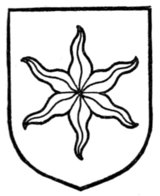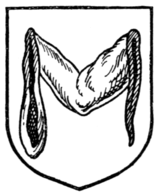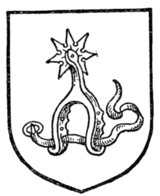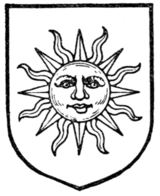Annulet
A roundel with a hole in the centre, like a ring
Argent
The tincture Silver
Billet
A small rectangle (usually vertical), representing bricks, books or tickets
Blazon
The symbol sitting at the top of the armorial
Buckle
An artistic representation of a buckle, but used by Earls, and Counts

Caped
Cut off at the neck
Catherine Wheel

Chapeau
Hat/ Ecclesiastical dignity
Clarion
A harp

Coat of Arms
The unique heraldic design on an escutcheon
Couchant
Lying down, head raised
Courant
At running speed, or in full chase
Crosses
Dexter
Right
Displayed
Wings outstretched
Ducal
Of the Duke
Erased
Looks like forcably torn off, i.e., head.
Escallop
The scallop shell - often used as a badge of pilgrims going to the Holy Land

Escarbuncle
Shields were strengthened by these iron bands

Escutcheon
Shield or Emblem bearing a Coat of Arms
Estoile
Wavy-armed star

Fitchee
To a point, i.e. a cross crosslet fitchee. Fitched - pointed end.
Fleam
A surgeon's lancet

Furs
Are the small patterns repeated on a shield, such as ermine (stoat) or vair (squirrel)
(look under tincture wiki)
Gamelle
One of Two, e.g. gemelle bars
Grenade
Fire ball

Guardant
Looking at you
Increscent
Horns turned Dexter
Halberd
Two handled pole weapon, sometimes axe/pole.
Lozenge
A diamond shape
Lodged
Martlett
Small bird - usually a swallow or lark.
Mascle
A lozenge shape voided
Mantle
A cloak, or a piece of fabric used to highlight the arms and the crest


Maunch
Ladies sleeve

Mill-rind
Iron from the centre of a grindstone

Mitre
Bishops Hat
Mullet
Star

Mural Crown
Representation of a city wall or towers in the form of a crown

Or
French for Gold
Pale
Band running straight up and down on shield
Passant
Animal striding/walking (on all fours)
Pheon
A broad arrow

Portcullis
Iron gate on a castle or fort

Rampant
Standing on hind legs
Regardant
Looking backward
Roundel
A round disc or ball
Salient
Of animal standing on hind legs as if leaping at the ready.
Saltire
Diagonal Cross
Scimitar
Type of sword

Sejant
Sitting upright (animal)
Semeé
Being embellished with - stars, etc
Sinister
Left
Spur
Used on the boots of armour

Statant
On all fours, but erect, e.g. lion.
The sun with a face, and arms of rays

Supporters
The figures placed on either side of the shield - usually humans or animals
Talbot
Dog or hunting dog
Tilting Spear
Weapon of the Day, used for tournaments

Tinctures
The colours used to emblazon a coat of arms. These are divided into metals, colours, stains, furs, and proper (coloured as it would be in nature).
Vulning
Wounded
Water bouget
The sticks with which water buckets were carried over the shoulders

Ordinaries
Simple geometrical feature, with straight lines running from side to side or top to bottom of the shield. Each represents a different aspect of the family, often with additions of motifs, colours, or patterns.
Sub-Ordinaries

Divisions of the Field

Lines of Partition

Variations of the Field


Crowns
(Most common being the Duke).
(Most common are the Mural, Ducal, and Naval crowns).
Other Heraldic Headwear
(Of these the most common in my research has been the chapeau, the mitre, and the chaplet).
Familial Position in Heraldry

(Of these the most common reocurring motifs have been the label, crescent, mullet, escallop, fleur-de-lis, and martlet).

















